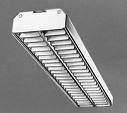Malfunctions of fluorescent lamps with electromagnetic ballasts and methods of their elimination
In this article, the most typical cases of malfunctions of fluorescent lamps and methods of their elimination are given.
1. The fluorescent lamp does not light
The reason may be a broken contact or a broken wire, broken electrodes in the lamp, a malfunction of the starter and insufficient voltage in the network. To identify and eliminate the malfunction, you must first replace the lamp; if it does not light up again, replace the starter and check the voltage at the holder contacts. In the absence of voltage in the contacts of the lamp holder, it is necessary to find and remove the open circuit and check the contacts in the places where the wires are connected to the ballast and the holder.
2. The fluorescent lamp flashes but does not glow, the glow is observed only from one end of the lamp
The cause of the malfunction may be a short circuit in the wires, the holder or in the terminals of the lamp itself.To identify and eliminate the malfunction, it is necessary to rearrange the lamp so that the glowing and defective ends are reversed. If this does not correct the fault, replace the lamp or look for a defect in the holder or wiring.
3. A dull orange glow is visible at the edges of the fluorescent lamp, which sometimes disappears, then reappears, but the lamp does not light
The cause of the malfunction is the presence of air in the lamp. This lamp needs to be replaced.
 4. The fluorescent lamp initially glows normally, but then there is a strong darkening of its edges and it goes out
4. The fluorescent lamp initially glows normally, but then there is a strong darkening of its edges and it goes out
Usually, this phenomenon is associated with a malfunction of the ballast resistance, which does not provide the necessary operating mode of the fluorescent lamp. In this case, the ballast must be replaced.
5. The fluorescent lamp periodically turns on and off
This can happen as a result of a lamp or starter malfunction. The lamp or starter must be replaced.
6. When the fluorescent lamp is turned on, the spirals burn out and the ends of the lamp turn black
In this case, you need to check the supply voltage and its compliance with the voltage of the connected lamp, as well as the resistance of the ballast. If the mains voltage matches the lamp voltage, then the ballast is faulty and must be replaced.
